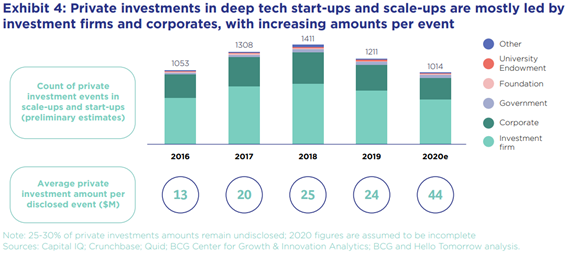Deep Tech – Part II – Innovation Inspires Investments
Last week, we talked about how deep tech is becoming the defining approach and mentality behind the majority of innovations and start-ups seen in the recent years, how this problem-oriented approach solves some of the inherent issues of the innovation model that popularized during the 1980s and how the public image of the entrepreneurs and companies, and the way some of these projects manage to compete with others that receive substantially more funding through governments and involve even coalitions of countries to achieve similar results.
For this second part on the deep tech approach, we will take a look at the financial side of the phenomenon, and how these projects have not only captured the attention of investors when compared to previous years, but also in contrast to projects based in previous innovation models, to fully paint the picture of how this mentality is forging the landscape of the future.
Catching Eyes
To find conclusive evidence that deep tech is stepping strong among start-ups and innovators, we should look no further than the investors’ sentiment and reaction to the increasing number of projects launching each year. A report released by BCG and Hello Tomorrow earlier this year shows how the total investments in Deep Tech has been growing steadily since 2016 and reached over $60 billion in 2020 (representing more than an 11% increase compared to 2019), which towers above the median funding achieved by non-deep tech start-ups, meaning that the increase in funding is not only related to a rise in the number of projects launched, but also their increase attractiveness towards investors.
This behavior is usually linked to private investors taking a leap of faith with new, innovative approaches, but the main trend reversal seen in 2020 was the increased participation of corporate investments in this wave of start-ups. Naturally, if the number of total deep tech projects keeps increasing but the reported count of private investments is reduced, it is a sign that corporate involvement is on the rise, which coincides with the recent trend of increased interest from large companies into economic sectors driven by technology like blockchain, cryptocurrency, digital assets, Internet-of-Things, and many more.
Securing Ideas
Another important aspect of deep tech start-ups that not only defines them from the previous wave of innovation but also generates a great amount of interest from investors is the trend to file patents to protect their technology. The exclusivity of the developed solutions not only translates into safe income, since the problem-based mentality ensures lower market risks, but also awakens a sense of urgency from investors to be able to receive a fraction of said revenue, as the report also shows that the equity investment is the portion of funding that has shown the most stable growth in the last few years.
Of course, the other point of view for this phenomenon could be that the exclusivity of the developed technologies could generate an increase in the privatization of the market, since corporate investors hold equity in solutions protected by patents. However, the increase in the number of projects helps combat this unfavorable possibility, offering alternatives in the form of multiple competing patents for solutions that solve similar problems, or in the 30% of projects that are released as an open-source solution.
However, it seems that one of the issues seen with non-deep tech projects permeates through into this new mentality: the lack of diversification in sectors and, thus, in investment. The clear bias seen in R&D spending towards computers, electronics, and healthcare we mentioned in Part I is translated into the sectors of life sciences and artificial intelligence taking up to two thirds of the total funding deep tech projects received in 2020.
With diversification being the main challenge and, consequently, the main driving force behind deep tech start-ups, we may see a wave of even more start-ups climbing the ranks and gaining significant funding if they plan to solve uncovered needs in sectors like transportation or energy generation, problematics that have worried many countries for decades and have seen relatively little development from both traditional innovation startups and governments through federal funding.
If a conscious effort is made from each start-up to differentiate themselves from the competition and the non-deep tech alternatives, doors may open in every technologic landscape for new solutions to arise and pave the way for future developments, at which point the focus shifts to new problems and the innovative cycle of deep tech continues.
Information and graphics from “Deep Tech: Innovation inspires Investments”, by BCG and Hello Tomorrow









